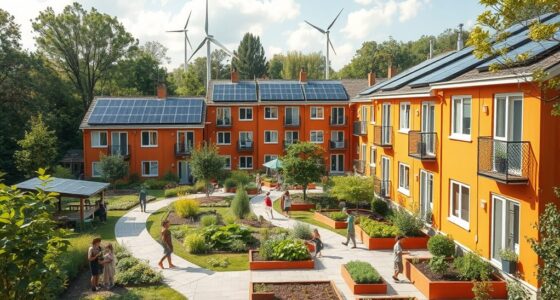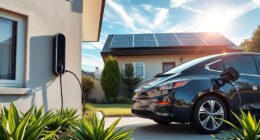Smart city sensors actively monitor pollution levels and environmental conditions in real time, helping urban planners target areas needing improvement. They provide valuable data to optimize traffic flow, create green spaces, and develop pollution-reducing infrastructure. While these technologies help clean our air, it’s essential to contemplate data privacy and security. If you want to explore how sensor data shapes healthier cities and the safeguards in place, keep going to discover more.
Key Takeaways
- Smart sensors continuously monitor air pollution levels, providing real-time data to identify hotspots and inform targeted cleanup efforts.
- Data from sensors helps urban planners develop green infrastructure, such as parks and green walls, to absorb pollutants and improve air quality.
- Sensors enable dynamic traffic management, like adjusting signals and restricting vehicle access, reducing emissions in high-pollution areas.
- Real-time pollution data supports policies and initiatives aimed at reducing emissions and promoting cleaner transportation options.
- Secure data collection and privacy protections ensure public trust, encouraging community participation in air quality improvement programs.

Smart city sensors are transforming urban living by providing real-time data that helps manage everything from traffic flow to environmental quality. When it comes to cleaning our air, these sensors play a vital role in shaping smarter urban planning strategies. By continuously monitoring pollution levels, they give city officials the detailed insights needed to implement targeted measures like adjusting traffic signals, restricting vehicle access in high-pollution zones, or increasing green spaces. This data-driven approach allows you to see how different factors impact air quality and enables more effective decisions that benefit everyone’s health and well-being.
However, as you rely more on these sensors, data privacy becomes an important concern. Smart city systems collect vast amounts of information, not just about pollution but also about your movement and daily habits. You have to wonder how this data is being protected, who has access to it, and how it’s being used. Cities need strict protocols to guarantee that personal information isn’t exploited or exposed, maintaining your trust while still harnessing the power of data to improve air quality. Balancing the benefits of environmental monitoring with the need for privacy requires transparent policies and advanced security measures.
In terms of urban planning, these sensors offer an unprecedented level of detail that can revolutionize how cities are designed and managed. For example, real-time air quality data helps planners identify pollution hotspots and allocate resources more efficiently. You might see new bike lanes or pedestrian zones in areas with poor air conditions or the development of green infrastructure to absorb pollutants. This data-driven planning makes your city more livable and sustainable, fostering healthier environments for you and future generations. It’s about creating urban spaces that respond dynamically to environmental challenges, making cities more adaptable and resilient.
Yet, the success of incorporating smart sensors into urban planning depends on your city’s ability to maintain trust around data privacy. If residents feel their information is safe, they’re more likely to support and engage with these initiatives. Transparency about what data is collected, how it’s stored, and how it’s used reassures you that your privacy isn’t being compromised. As urban planners leverage sensor data to improve air quality, they must also prioritize safeguarding citizens’ rights, ensuring that technological advancements don’t come at the expense of personal privacy. Incorporating sensor maintenance best practices helps ensure the longevity and accuracy of data collected.
Ultimately, smart city sensors are powerful tools that can greatly improve air quality and urban living. By providing detailed environmental data, they enable smarter planning and more effective pollution control. But to fully realize these benefits, city officials and residents like you need to work together to protect data privacy, ensuring that the move toward smarter, cleaner cities is both effective and ethically sound.
Frequently Asked Questions
How Accurate Are Air Quality Sensors in Urban Environments?
You might wonder how accurate air quality sensors are in urban environments. Generally, their accuracy depends on proper sensor calibration and regular data validation. When sensors are well-calibrated, they provide reliable readings, but environmental factors like pollution levels and weather can affect results. Data validation helps identify and correct discrepancies, ensuring you get a true picture of air quality. So, with proper maintenance, these sensors can be quite accurate in cities.
What Cybersecurity Measures Protect Smart City Sensor Data?
Imagine your data as a delicate glass sculpture—protecting it is vital. You, as a user, benefit from encryption protocols that lock your sensor data behind digital vaults, preventing unauthorized access. Data anonymization further shields your identity by removing personal details. These cybersecurity measures work together, ensuring your sensor data remains private and secure amid increasing cyber threats, so you can trust the smart city’s technology to serve you safely.
How Do Sensors Differentiate Between Pollution Sources?
You might wonder how sensors differentiate pollution sources. They use pollution source identification techniques, analyzing specific chemical signatures to pinpoint whether traffic, industry, or natural sources are responsible. Proper sensor calibration guarantees accurate readings, enabling precise source detection. By continuously calibrating sensors and employing advanced algorithms, you can rely on their ability to distinguish pollution sources effectively, which helps targeted air quality improvements and pollution control strategies.
Are Sensors Capable of Predicting Future Air Quality Trends?
Imagine the sensors as vigilant eye-spies, constantly gathering data. With predictive analytics, they forecast future air quality trends, like reading the weather before it arrives. Proper sensor calibration guarantees accuracy, so these predictions stay reliable. You can trust that as data flows in, the sensors help city managers anticipate pollution spikes, giving you cleaner air and a healthier environment ahead. This proactive approach transforms raw data into a clear vision of the future.
What Is the Maintenance Cost of Smart City Sensors?
You wonder about the maintenance cost of sensors, which depends on their lifespan and maintenance scheduling. Typically, sensors need regular calibration, cleaning, and software updates, which can be cost-effective if scheduled properly. On average, maintenance costs range from a few hundred to a thousand dollars annually per sensor. Proper planning guarantees your sensors stay functional, accurate, and reliable, ultimately saving you money and extending their lifespan.
Conclusion
With smart city sensors working tirelessly, you’re witnessing a future where the air is so pure, it feels like breathing in a slice of heaven. These tiny devices battle pollution with superhero strength, turning our cities into sparkling, breath-friendly havens. Imagine a world where every breath you take is cleaner than the last—thanks to these incredible technologies. It’s not just a dream; it’s happening now, transforming our cities into the cleanest, freshest places you’ve ever known.










